The Importance of Physiological Adaptations in the Competitive Success of High Performance Romanian Judoka Athletes
Abstract
The strong link between the physiological adaptations of Romanian judo athletes who are preparing for high performance and the technical skills of the athletes is often difficult to determine and assess. Judo is a sport in which strategy and technique are dominant in obtaining performance, while the physiological characteristics and their parameters form the basis on which the judoka athlete builds the technical performance and individual tactics. The research subjects are components of judo Olympic teams from Romania, male and female. Methods of assessing anaerobic and aerobic exercise capacity are used. The research results on the effects of adaptive anaerobic effort capacity allow emphasizing the short, intensive but maximal capacity to express the muscle strength in this type of sport. The paper conclusions demonstrate the importance of adaptive effects that have occurred in the investigated athletes regarding the anaerobic and aerobic effort capacity, as an effect of intense training specific to competitive strain during a judo match, but especially during extra time periods, in those cases where the final decision has not been made in the regular time frame of five minutes. Top Romanian judoka athletes are characterized by high values of muscular strength and power, particularly in the upper parts of the body. Ideally, the judoka athletes should maintain an optimal ratio between physical preparation and technique through an optimal combination of technical and physical shape. Maintaining the optimal ratio between the training components and physical preparation ensures the most effective outcomes for obtaining high performance.
Keywords: Judo, training, physiological adaptations, high performance
Introduction
Judo Olympic discipline, practiced throughout the world, at all ages, has a fundamental contribution
to the physical and mental development of practitioners, being considered nowadays a very important
method in youth education (Sterkowicz & Emerson, 2000). Currently, more and more studies show that
judoka athletes have very high adaptation capacity to complex exercises, exceptional endurance,
reaction and performance capacity, and a high level of coordination, of static and dynamic balance
positions (Sale & Jacobs, 1990). This high level of preparation and the specific adaptation to complex
effort are determined by the presence of weight classes and many biomechanically different structures
occurring in the techniques and the attack and defence elements. All these issues involved in judo
preparation amplify and complicate the training of athletes, and also the permanent increase in their
performance capacity. Recent studies demonstrate the crucial importance of specific adaptations of
lactacid anaerobic capacity for judoka athletes, which is very important in winning the victory and is
revealed by athletes’ results in the speed-endurance, coordination, reaction and execution speed tests
(Sbriccoli et al., 2007).
Top performance judoka athletes are characterized by very high values of muscle strength and
power, especially in the upper parts of the body (Nurkić et al., 2009).
Theis to determine the adaptation level of performance judoka athletes to
alactacid anaerobic effort and also their cardiovascular adaptations to specific effort using lab methods.
The are to determine the level of research on the adaptations specific for
judoka athletes of national and international levels, members of the Olympic team, to establish the
research hypotheses, the methods for collecting specific data, for assessing, analysing, processing and graphically representing the collected data, to interpret the research data, to present the results and proposals.
Based on these aspects, in achieving the paper, we have started from the fundamental hypothesis that determining the physiological adaptation to specific factors and its contribution to the performance structure has a crucial role in increasing exercise capacity of judoka athletes, that the relationships between these factors and the importance given to them by the domain experts (coaches, teachers, methodologists) significantly contribute to determining optimal training strategy, planning and programming in judo.
Materials and methods
In order to obtain the research data, there were used methods for assessing aerobic and anaerobic
exercise capacity, coordination, technical and tactical preparation, as well as statistical methods. Using
the questionnaire method, there were collected data for determining the relationship between different
factors of performance capacity in judo. In the research, there were used data provided by the Olympic
coaches of the Romanian Judo Federation. The research subjects are components of the Olympic judo
teams from Romania, male and female, randomly distributed by weight class in order to collect
objective data for each technical-tactical model, and physiological adaptation model as well (Bocioacă,
2008). The subjects were assessed during the research period under the same conditions and received
specific technical assistance and similar preparation methods.
Results
Data on the development of anaerobic capacity obtained during the three testing stages, namely the
initial, intermediate and final ones, by applying the Sargent Test, have shown a significant increase in
the anaerobic capacity. The increase was recorded in the course of a complete cycle of preparation,
when the athletes had a peak of their sports shape, with very good results in international competitions.
In Table 1, there are presented the results obtained by each subject for Sargent Test, the average,
standard deviation, and the T-test values correspond to the weight class in the initial, intermediate and
final assessments.
In the following figures, there are graphically displayed the data obtained from the 14 judoka
subjects, members of the Olympic team, during the three tests (initial, intermediate and final ones) for Sargent Test. Figure 1 shows the development of anaerobic capacity in the initial assessment, for each
subject, by determining the power in watts, the best scores being obtained by the athletes from 48kg, 73 kg and 57 kg weight classes, considered as landmark classes for explosive efforts.
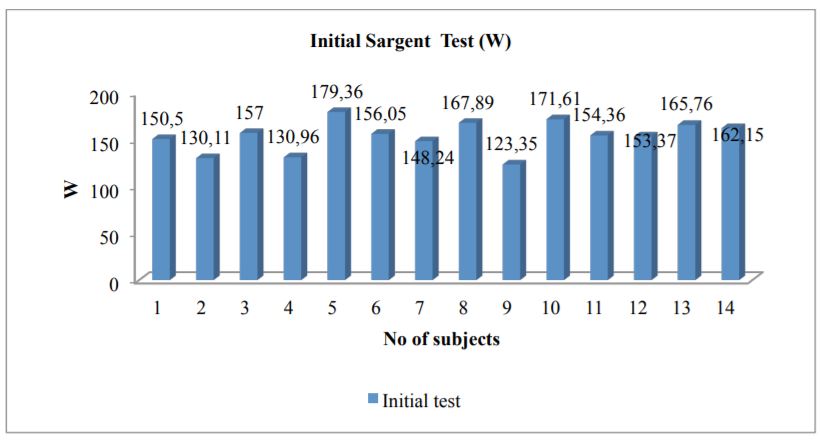
Figure 2 shows the development of anaerobic capacity in the intermediate assessment, where there
are found increasingly higher values for the same weight classes and a significantly increased
adaptation to anaerobic efforts.
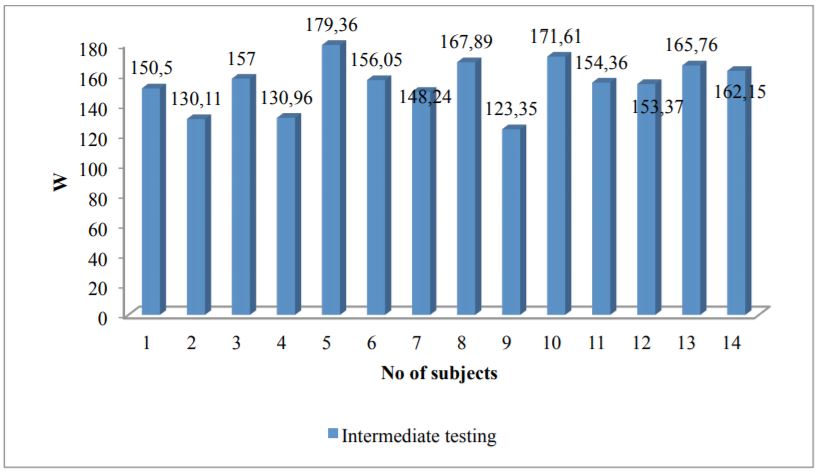
Figure 3 shows the development of anaerobic capacity in the final assessment. In this case too, there
is a significant increase in the anaerobic capacity (T-test with values of 0.60), which confirms the
research hypothesis. The highest values are recorded by judoka athletes in the weight classes with
specifically high power and strength.
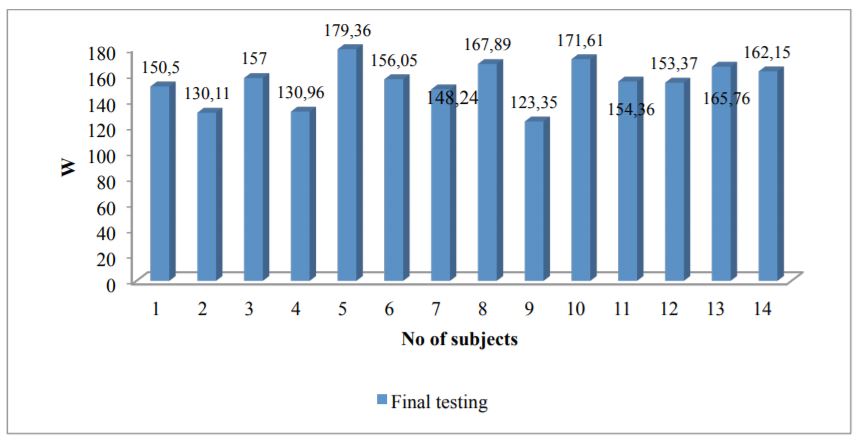
In the following figures, there are graphically displayed the data obtained by subjects from various
weight classes, using the modelled representation of the results in the plethysmographic (pleth) test,
graphical representations showing the evolution of the relationship between pleth signal and the initial,
intermediate and final assessments. In Figure 4, there are represented the pleth signal evolutions in the
initial assessment, where it is observed low plethysmographic signal, with a low circulatory adaptation level of the athletes.
In Figure 5, it is observed the model middle pleth signal to keep the intermediate signal
characteristics, with a higher level of intensity in volts, and increased parameters of ventricular
capacity function, indicated by the red and blue colours of the signal.
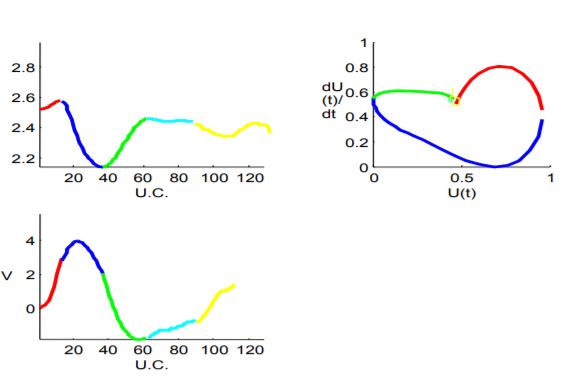
In Figure 6, it is observed the end of signal pleth wave, with high values of significant signal (values
greater than 4 volts), which shows a high capacity of adaptation of athletes, from the point of view of aerobic and anaerobic efforts.
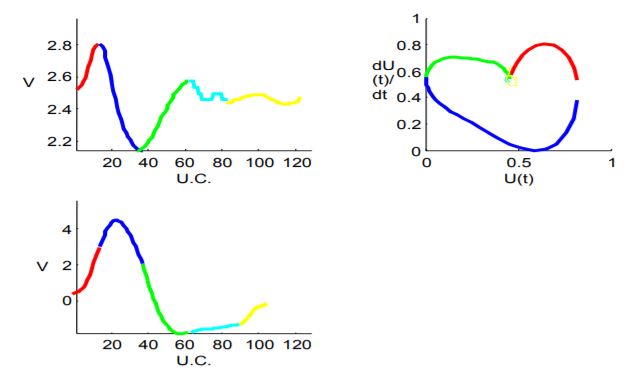
Discussions and conclusions
Data recorded by the research subjects throughout the experiment show significant increases in the
exercise capacity. Specific adaptations to anaerobic efforts are revealed by changes in the data obtained
for Sargent Test, with average values of 144.80W, 150.58W, 153.62W. The values entered for processing the data by T-test demonstrate significant increases, for all judoka subjects, at the end of the
experiment. The values recorded by the calculated T-test, 0.29, 0.60, 013, demonstrate validation of the
research hypothesis. The values determined by calculating the standard deviation, 13.69, 14.54, 16.28,
show a distribution with high variability of the results, due to various adaptations caused by the
specific demands of different weight classes, the physiological adaptation, as well as the technical and
tactical one. As regards the values recorded by subjects in the three tests for the pleth signal, it can be
found significant variability between the results of subjects prepared under the same experimental
conditions, but also the different results of circulatory adaptations for the same subject. Significant
increases in the exercise capacity and the adjustments of anaerobic circulatory capacity, demonstrated
by the results in the initial and final testing, are determined by the efforts of high intensity and
complexity specific to judo discipline.
Data obtained by us, showing significant increases in both the anaerobic and aerobic capacity of
performance judoka athletes indicate important physiological adaptations of specific shape (Hantău &
Bocioacă, 1998: 110) in order to obtain high sports performance in judo (Sinanović, Ilić, & Ilić, 2011:
69).
References
Bocioacă, L. (2008). Dezvoltarea calităților motrice. București: Moroșanu.
Hantău, I., & Bocioacă, L. (1998). Antrenamentul în judo: pregătirea fizică și tehnică. Pitești: Editura Universitații.
Nurkić, M., Bratić, M., Radovanović, D., & Bojić I. (2009). The effects of preparation period training program on functional abilities of first class judokas. In M. Mikalački (Ed.), Proceeding Book of the 1st International Scientific Conference Exercise and Quality of Life (pp. 333-338). Novi Sad, Serbia: Faculty of Sport and Physical Education University of Novi Sad.
Sale, D. G., MacDougall, J. D., Jacobs, I., & Garner , S. (1990). Interaction between concurrent strength and endurance training. Journal of Applied Physiology, 68(1), 260-270.
Sbriccoli, P., Bazzucchi, I., Di Mario, A., Marzattinocci, G., & Felici, F. (2007). Assessment of maximal cardiorespiratory performance and muscle power in the Italian Olympic judoka. Journal of Strength Conditioning Research, 2(3), 738-744.
Sinanović, J., Ilić, I. I., & Ilić, H. S. (2011). The differences in growth characteristics and body composition of students and judoists. Sports Science and Health, 1(1), 69-74.
Sterkowicz, S. & Emerson, F. (2000). A comparison of techniques used by lightweight and heavyweight judoist during the World and Olympic tournaments (1995-1999). IJF World Judo Conference Research Paper. [International Judo Federation].
Copyright information

This work is licensed under a Creative Commons Attribution-NonCommercial-NoDerivatives 4.0 International License.
About this article
Publication Date
10 June 2016
Article Doi
eBook ISBN
978-1-80296-010-5
Publisher
Future Academy
Volume
11
Print ISBN (optional)
-
Edition Number
1st Edition
Pages
1-509
Subjects
Sports, sport science, physical education
Cite this article as:
Bocioaca, L. (2016). The Importance of Physiological Adaptations in the Competitive Success of High Performance Romanian Judoka Athletes. In V. Grigore, M. Stanescu, & M. Paunescu (Eds.), Physical Education, Sport and Kinetotherapy - ICPESK 2015, vol 11. European Proceedings of Social and Behavioural Sciences (pp. 483-489). Future Academy. https://doi.org/10.15405/epsbs.2016.06.67

